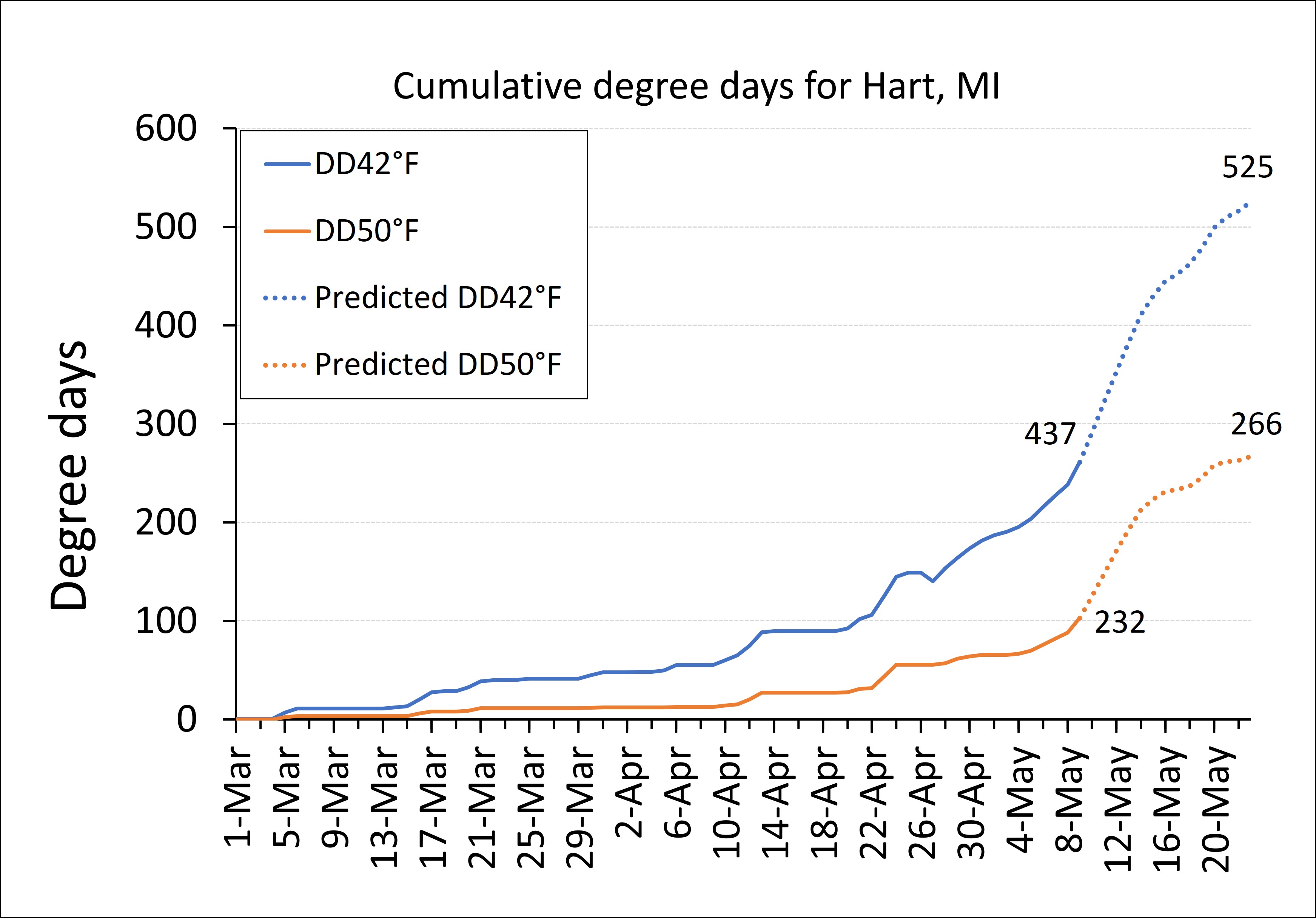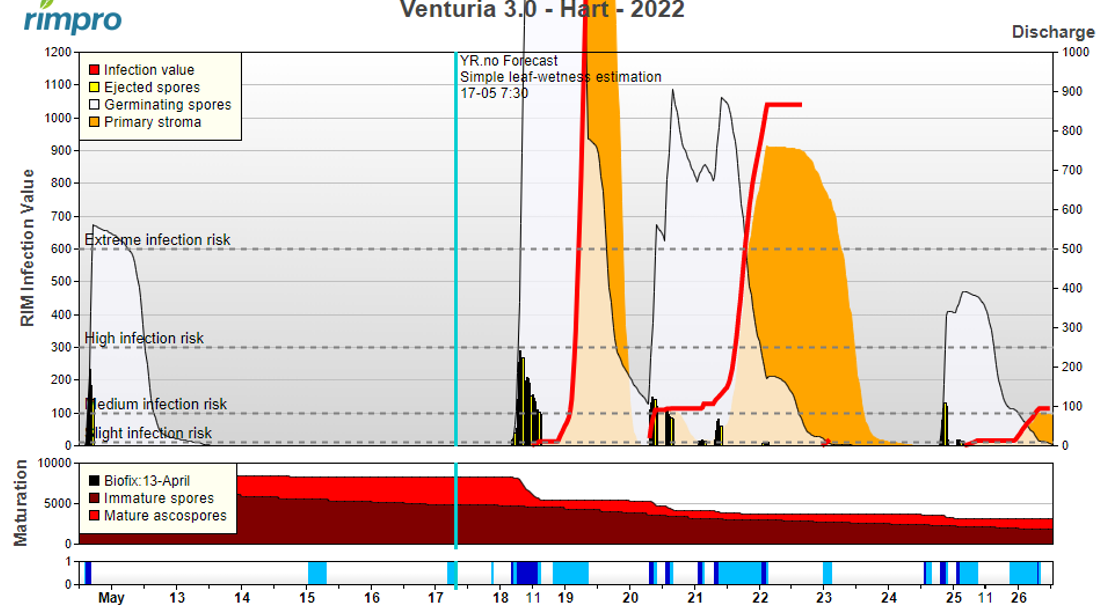West central Michigan tree fruit update – May 17, 2022
Warm weather has rapidly advanced bud development this week, and some fruit trees will be in bloom by the end of the week.

Weather update
Warm weather last weekly rapidly advanced tree phenology. Bloom for cherry, apple, peach, and pear occurred at similar timings across west central Michigan (Figure 1). Some tree fruit will be at petal fall by the end of the week. Based on the Hart weather station for May 16, current GDD accumulation is 437 GDD42 and 232 GDD50 (Figure 2). Across the region, DD accumulation is now above the five-year average, but accumulation will slow this week (Table 1).
Weather will remain cool for the next few days with a warmup toward the end of the week. Highs will be in the 70s on May 19 and 20. Cooler temperatures will follow with highs in the 50s and lows in the 40s over the weekend.
A popup storm occurred on Wednesday, May 11 which brought over an inch of rain in some West Central locations as well as high winds and scattered hail. For this week, rain is predicted for Wednesday, May 18 and Saturday, May 21.
|
Station |
2022 DD Base 42 F |
5-yr Avg DD Base 42 F |
2022 DD Base 50 F |
5-yr Avg DD Base 50 F |
|
Benona/Shelby |
407 |
296.3 |
214 |
109.9 |
|
Elbridge/Hart |
438 |
376.7 |
236 |
166.7 |
|
Fremont |
467 |
421.9 |
251 |
191.4 |
|
Grant* |
481 |
413.4 |
256 |
188.3 |
|
Hart |
437 |
367.2 |
232 |
159.0 |
|
Ludington |
428 |
351.5 |
229 |
149.4 |
|
Mears** |
450 |
373.0 |
242 |
164.6 |
|
New Era** |
440 |
368.6 |
235 |
159.1 |
*Averages were calculated using data from 2020-2021.
**Averages were calculated using data from 2018-2021.

Weather data was gathered from MSU Enviroweather.
More information and reports on normal weather conditions and departures from normal can be found on the NOAA Climate Prediction Center website, NOAA U.S. Climate Normals website, NOAA Climate Normals Quick Access Page (which may be searched by region) and Midwest Regional Climate Center website.
Crop update
Cool weather will slow down tree growth and extend bloom this week. With an extended bloom, growers should consider how to protect and support native and commercial bees. Growers should delay spraying until bloom is over to prevent risk to pollinators. If there is pest and disease pressure during bloom that reaches economic thresholds, growers may need to spray to protect the crop. Rufus Isaacs and Julianna Wilson from Michigan State University recommend reducing risk to pollinators by applying pesticides that are 1) allowed for use during bloom and 2) have the lowest toxicity to bees. Growers should apply pesticides when bees are not actively foraging and when conditions are unlikely to cause drift. Bumble bees and honey bees also forage over a few miles to crop and non-crop flowers. To reduce honey bee pesticide exposure risk within the orchard, growers can mow flowers off attractive ground covers.
Apple varieties in the West Central region range from bloom to petal fall. Early varieties such as Zestar and Idared are at petal fall. Later varieties such as Gala and Honeycrisp are at full bloom. Hart is at 437 DD42 and 232 DD50. Growers are advised to consider thinning fruit early, starting with blossom thinning. Blossom thinning is particularly beneficial for varieties that initiate flower bud formation early (in July) for the following season such as Honeycrisp, Minneiska, Macoun, Fuji, and Golden Delicious. In a Cornell University study, blossom thinning increased return bloom more than thinning at the 10-12 mm stage in Honeycrisp and Fuji.
For more thinning recommendations, growers can access the 2022 Thinning Guide.
For specific information on thinning strategies for Honeycrisp in 2022, check out this article from MSU Extension specialist, Anna Wallis, Honeycrisp Crop Management for 2022.
Tart and sweet cherry buds range from bloom to shuck split.
Peaches buds range from bloom to petal fall.
Pear varieties range from bloom to petal fall.
Pest and disease update
In the west central region, cooler temperatures will slow pest activity this week. Consider your scouting reports and block history to target hot spots for early season pests in the orchard according to growth stage.
Early season pests
Black stem borer adults are active in warmer temperatures. Trapping near woodlots or injured trees is recommended to monitor for flight of females.
European red mite is in the hatch stage and will continue through bloom. Warm and dry conditions are favorable for egg hatch and larvae activity. Growers should scout for European red mites in apple and pear.
Obliquebanded Leafroller is predicted to have sustained catch in late May due to the cooler weather this week. Sustained catch is expected at 900 DD42. Scout orchard blocks in the coming weeks to determine if a spray is needed. Consider Bt sprays in problem blocks.
Oriental fruit moth biofix 1 is estimated to have occurred on May 9. Straps and lures should be placed in orchards now. Be sure to scout orchards and problem blocks.
Pear psylla adults and newly laid eggs were found in the region. Early management is key to keeping damage thresholds low through the season.
Redbanded Leafroller adult flight is low in the region. Continue to monitor this minor tree fruit pest.
Rosy apple aphid is a common pest in our region. Growers can scout for colonies of dark purple nymphs in fruit clusters and treat blocks as needed.
San Jose scale is present in some orchards in the region. Targeted sprays or oils can be used for infested trees to manage scale and target adults. Growers should monitor in blocks where scale were present on fruit in 2021. San Jose scale may feed on apple, pear, plum, apricot, and sweet cherry.
Spotted tentiform leafminer activity may be low this week due to cooler temperatures. Adults have been trapped in low numbers in the region. Larvae that feed on sap of leaves may not be present for 1 or 2 more weeks.
Apple scab
RIMPro forecast is predicting that extreme infection risk for an apple scab infection on May 19 and 22 (Figure 3). Wettings events are predicted on May 18 and May 21. Also, warmer weather means that the scab fungus, Venturia inequalis, is more active and can infect leaf tissue quickly. Again, with rapid tree growth in our region, it is important to protect new growth with adequate fungicide coverage. Coverage will also be important for pear blocks in the region for pear scab (Venturia pirina).

Powdery mildew
Warm temperatures and high humidity this week may result in powdery mildew infection. Powdery mildew is caused by the fungus Podosphaera leucotricha. It affects apples and pears and causes infections on the underside of the leaf that lead to chlorotic patches or spots on the upper side of the leaf. It is important to manage powdery mildew because infected blossoms can cause poor fruit set or stunted and russetted fruit. Note that sterol inhibitors, strobilurins, and succinate dehydrogenase inhibitors control powdery mildew. Captan, Scala, Vangard, and EBDC fungicides will not control powdery mildew. Growers should spray for powdery mildew from tight cluster or bloom through midsummer.
Cherry leaf spot
Tart cherry growers should begin cherry leaf spot management programs if they have not already. Wetting events this week may lead to infection periods for the cherry leaf spot fungus, Blumeriella jaapii. Disease pressure was high in 2021 in West Central, and maintaining coverage of new tissue will be critical this season.
Fire blight
To manage American brown rot in cherry and peach, growers can apply fungicides at petal fall and shuck fall. Warm and wet conditions favor development of the American brown rot pathogen, Monolinia fructicola, in cherry and peach.
For pest and disease management recommendations, please refer to the E-154 for product guidelines.
For more information about regional reports, please visit the Michigan State University Extension webpage.



 Print
Print Email
Email

